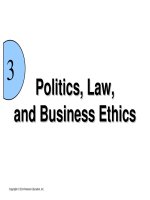Lecture International business - Chapter 4: Economics and emerging markets
Bạn đang xem bản rút gọn của tài liệu. Xem và tải ngay bản đầy đủ của tài liệu tại đây (1.77 MB, 37 trang )
4
Economics and
Emerging Markets
Copyright © 2014 Pearson Education, Inc.
Chapter Objectives
•
Describe what is meant by a centrally planned economy and
explain why its use is declining
•
Identify the main characteristics of a mixed economy and
explain the emphasis on privatization
•
Explain how a market economy functions and identify its
distinguishing features
•
Describe the different ways to measure a nation’s level of
development
•
Discuss the process of economic transition and identify the
obstacles for business
Copyright © 2014 Pearson Education, Inc.
4-2
Infosys
• Infosys is a global provider of IT services
• India has organic-led path to development
• Brainpower is driving development
Copyright © 2014 Pearson Education, Inc.
4-3
Economic Systems
Centrally Planned
Mixed
Market
Government ownership of
Mostly private (individual
economic resources and
or business) ownership of
state planning
economic resources
Government and private
ownership of economic
resoures split rather evenly
Copyright © 2014 Pearson Education, Inc.
4-4
Range of Economic Systems
Copyright © 2014 Pearson Education, Inc.
4-5
Centrally Planned Economy
Government owns most land,
factories, and other economic
resources and plans nearly all
economic activity
Welfare of the group
is paramount
Economic and social
equality is the goal
Asia
Central Europe
Eastern Europe
Latin America
Russia (1917)
China (1949)
Cuba (1959)
“Communist” system
is needed
Copyright © 2014 Pearson Education, Inc.
4-6
Decline of Central Planning
Central planning failed to:
Create economic value
Provide incentives
Achieve rapid growth
Satisfy consumer needs
Copyright © 2014 Pearson Education, Inc.
4-7
North Korea
Copyright © 2014 Pearson Education, Inc.
4-8
Focus on China
Socialism with
Chinese characteristics:
Challenges ahead:
Communist after civil
war ended in 1949
Political problems and
social unrest
Agricultural reforms
began in 1979
Unemployment and
migrant labor
Township and Village
Enterprises legal in 1984
Eventual(?) reunification
with Taiwan
Aggressive reforms since
Copyright © 2014 Pearson Education, Inc.
4-9
Mixed Economy
Government and private parties share ownership of land,
factories, and other economic resources rather evenly
Noble goals:
But stagnant:
Low unemployment
and poverty
State-owned businesses
less competitive
Steady economic growth
Prices and taxes higher,
living standards mixed
Equitable distribution
of wealth
Copyright © 2014 Pearson Education, Inc.
4 - 10
Benefits of Privatization
Privatization aims to:
Increase economic efficiency
Boost productivity
Raise living standards
Copyright © 2014 Pearson Education, Inc.
4 - 11
Discussion Question
A __________ economy is
one in which government
and private parties share
ownership of economic
resources rather evenly.
a. Centrally planned
b. Systemic
c. Mixed
Copyright © 2014 Pearson Education, Inc.
4 - 12
Answer to Discussion Question
A __________ economy is
one in which government
and private parties share
ownership of economic
resources rather evenly.
a. Centrally planned
b. Systemic
c. Mixed
Copyright © 2014 Pearson Education, Inc.
4 - 13
Market Economy
Private parties (individuals or businesses) own most
land, factories, and other economic resources
Supply
Demand
Quantity producers
will provide at a
specific selling price
Quantity buyers will
purchase at a
specific selling price
Copyright © 2014 Pearson Education, Inc.
4 - 14
LaissezFaire Economics
Less government
interference in business
Free choice
• Alternative purchase options
Free enterprise
• Firms choose products and markets
Price flexibility
• Prices follow supply and demand
Copyright © 2014 Pearson Education, Inc.
4 - 15
Government’s Role in a
Market Economy
Enforce antitrust laws
Preserve property rights
Provide fiscal and
monetary stability
Preserve political stability
Copyright © 2014 Pearson Education, Inc.
4 - 16
Enforce Antitrust Laws
Encourages development of industries with as
many competing businesses as market will sustain
Keeps consumer prices in check
Prevents growth-stunting monopolies
Copyright © 2014 Pearson Education, Inc.
4 - 17
Preserve Property Rights
Encourages risk-taking by people and business as
claims to assets and future earnings are protected
Market economy needs strong property
rights
Firms create new technologies and products
Entrepreneurs start new businesses
Copyright © 2014 Pearson Education, Inc.
4 - 18
Provide Fiscal & Monetary Stability
Encourages commerce in a nation because it
improves its reputation as a place to do business
Fiscal policies (taxation, government spending)
Monetary policies (money supply, interest rates)
Reduces overall uncertainty
Improves business forecasts
Holds inflation and unemployment low
Copyright © 2014 Pearson Education, Inc.
4 - 19
Preserve Political Stability
Encourages businesses to engage in activities
without fear of disrupted future operations
Promotes economic growth generally
Reduces worries of political risk
Improves chances for business survival
Copyright © 2014 Pearson Education, Inc.
4 - 20
Discussion Question
What are the three
required features
and four expected
roles of government
in any market
economy?
Copyright © 2014 Pearson Education, Inc.
4 - 21
Answer to Discussion Question
Three key features of a market
economy: free choice, free
enterprise, and price flexibility.
Four roles of government in a
market economy: enforce
antitrust laws, preserve
property rights, provide fiscal
and monetary stability, and
preserve political stability.
Copyright © 2014 Pearson Education, Inc.
4 - 22
Economic Freedom & Wealth
Source: Index of Economic Freedom (Washington, D.C.: Heritage Foundation, 2006), (www.heritage.org).
Copyright © 2014 Pearson Education, Inc.
4 - 23
Economic Development
Economic well-being of one
nation’s people relative to
another nation’s people
Economic output (agricultural,
industrial, and service)
Infrastructure (communications,
transportation, and power)
People (physical health and
education level)
Copyright © 2014 Pearson Education, Inc.
Productivity
Ratio of outputs (that are
created) to inputs (resources
used to create output)
4 - 24
National Production
GDP is the value of goods and services that a nation produces
during a one-year period (GNP adds international activities)
* POTENTIAL PROBLEMS *
Overlook certain transactions
Ignore economic growth rates
Averages can disguise regions
May ignore purchasing power
Copyright © 2014 Pearson Education, Inc.
4 - 25









